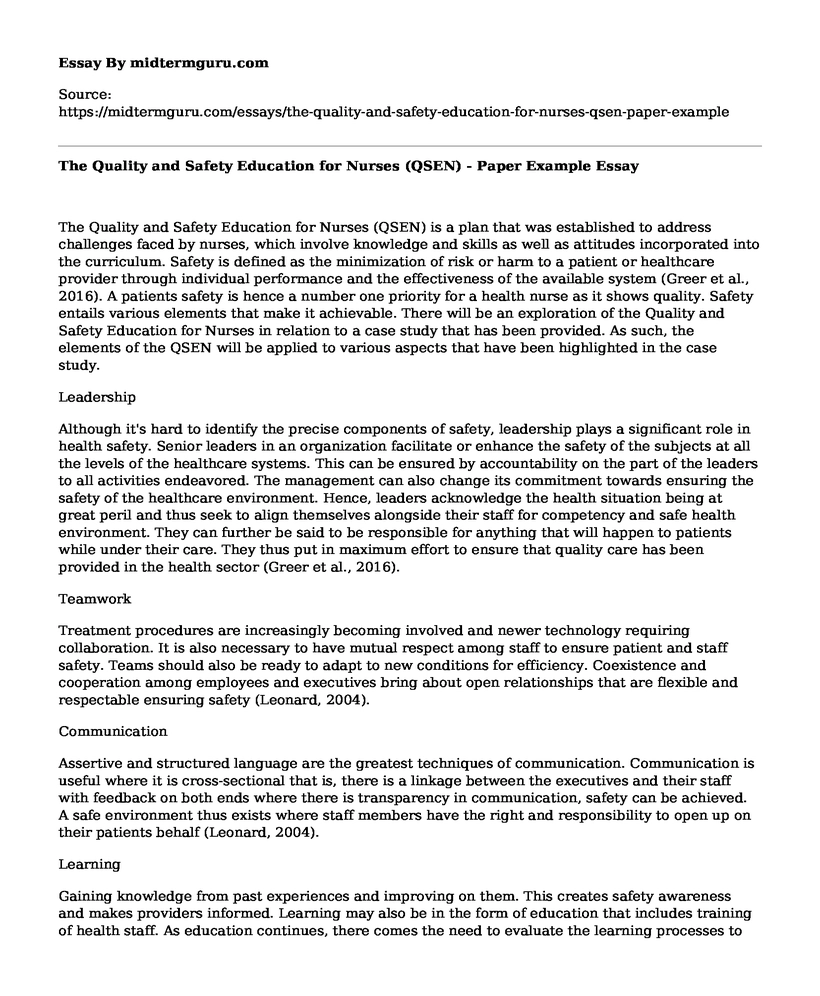The Quality and Safety Education for Nurses (QSEN) is a plan that was established to address challenges faced by nurses, which involve knowledge and skills as well as attitudes incorporated into the curriculum. Safety is defined as the minimization of risk or harm to a patient or healthcare provider through individual performance and the effectiveness of the available system (Greer et al., 2016). A patients safety is hence a number one priority for a health nurse as it shows quality. Safety entails various elements that make it achievable. There will be an exploration of the Quality and Safety Education for Nurses in relation to a case study that has been provided. As such, the elements of the QSEN will be applied to various aspects that have been highlighted in the case study.
Leadership
Although it's hard to identify the precise components of safety, leadership plays a significant role in health safety. Senior leaders in an organization facilitate or enhance the safety of the subjects at all the levels of the healthcare systems. This can be ensured by accountability on the part of the leaders to all activities endeavored. The management can also change its commitment towards ensuring the safety of the healthcare environment. Hence, leaders acknowledge the health situation being at great peril and thus seek to align themselves alongside their staff for competency and safe health environment. They can further be said to be responsible for anything that will happen to patients while under their care. They thus put in maximum effort to ensure that quality care has been provided in the health sector (Greer et al., 2016).
Teamwork
Treatment procedures are increasingly becoming involved and newer technology requiring collaboration. It is also necessary to have mutual respect among staff to ensure patient and staff safety. Teams should also be ready to adapt to new conditions for efficiency. Coexistence and cooperation among employees and executives bring about open relationships that are flexible and respectable ensuring safety (Leonard, 2004).
Communication
Assertive and structured language are the greatest techniques of communication. Communication is useful where it is cross-sectional that is, there is a linkage between the executives and their staff with feedback on both ends where there is transparency in communication, safety can be achieved. A safe environment thus exists where staff members have the right and responsibility to open up on their patients behalf (Leonard, 2004).
Learning
Gaining knowledge from past experiences and improving on them. This creates safety awareness and makes providers informed. Learning may also be in the form of education that includes training of health staff. As education continues, there comes the need to evaluate the learning processes to share lessons and hence performance improvement (Sherwood, 2011).
The plan should be carried out for at least a year. This is to allow enough time for the new staff to incorporate the safety learns for effective implementation. Once all the ideas have been absorbed, the staff can now ensure safety to the health environment. Once the plan is in place, surveys can be conducted for evaluation purposes. The Agency for Healthcare Research and Quality can conduct medical and hospital studies to assess the programs effectiveness. Additionally, internal reports can be generated periodically, say one month to evaluate performance. The proposal is sustainable as the process of learning is continuous and hence ensuring its continuous existence.
References
Greer, M., Curdy, N., Kopolow, A. and Mercado, S. (2016). Competencies for Patient Safety and Quality Improvement. The Joint Commission Journal on Quality and Patient Safety, 42(10), p.479.
Leonard, M. (2004). The human factor: the critical importance of effective teamwork and communication in providing safe care. Quality and Safety in Health Care, 13(suppl_1), pp.85-90.
Sherwood, G. (2011). Integrating quality and safety science in nursing education and practice. Journal of Research in Nursing, 16(3), pp.226-240.
Cite this page
The Quality and Safety Education for Nurses (QSEN) - Paper Example. (2021, Jun 17). Retrieved from https://midtermguru.com/essays/the-quality-and-safety-education-for-nurses-qsen-paper-example
If you are the original author of this essay and no longer wish to have it published on the midtermguru.com website, please click below to request its removal:
- Security Failures that Occurred in this Scenario of Hospital - Paper Example
- Paper Example on Health Problems among Adolescents, Young Adults, and Adults
- Paper Example on Physician-Assisted Suicide and Hospital Policy
- Treatment of Children With Autism - Research Paper
- Article Analysis Essay on Women and Leadership: Selection, Development, Leadership Style, and Performance
- Successful Interview: Jane's Story of Quitting Drug Addiction - Essay Sample
- The Calling of a Medic: A Journey to Service and Fulfillment - Essay Sample







